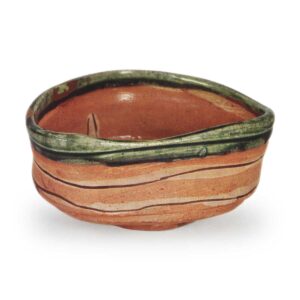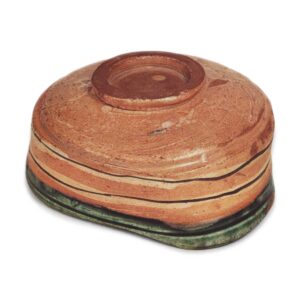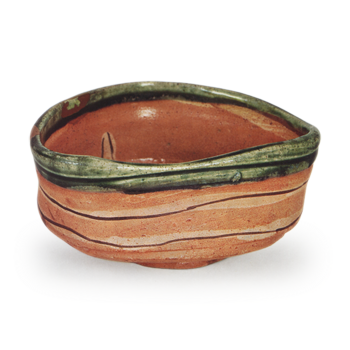

Height: 6.2 L 7.0 cm
Diameter: 11.9 – 14.0 cm
Outer diameter of foot: 5.8 – 6.0 cm
Height of foot: 0.7 cm
These types of tea bowls, known as Aka-Oribe or Narumi-Oribe, are relatively rare, and there are only a few that are of excellent quality.
The date of production is thought to be from the latter part of the Keicho era to the beginning of the Genwa era, and as is recorded in the “Kusajinoki” (“The Book of Trees and People”) in the first year of the Genwa era, “The tea bowls are the latest in the style of Imayaki, which has been produced in Seto for many years”, it is clear that these tea bowls were one of the most popular types of tea bowl at the time, along with the black Oribe tea bowls.
As with the black Oribe tea bowls, as the practice of applying different glazes and decorating with patterns became more popular, the style of tea bowls became more formal, and the distinctive use of the brush seen in Shino tea bowls almost disappeared. This is probably because the emphasis was placed on mass production, and rather than putting effort into the molding of each piece, they began to mass produce them by making changes to the typical shape by varying the colors and patterns on the surface. Therefore, although this type of tea bowl is light and varied, it usually lacks a dignified atmosphere and a calm, refined taste.
In this respect, this Aka-Oribe tea bowl is no exception, and the general tone of the piece is very light and airy. Although it is colorful, with its red background, cast-colored lines, two white stripes, and green rim, it is not a piece of high quality. However, even so, it is still one of the outstanding pieces, and if it is used as a replacement tea bowl for thin tea, it is a very useful tea bowl.
The foot ring is very plain and round, and although the waist of the body is also decorated with a single line of carving, it is difficult to say that it is very formal or powerful.
The rim is slightly thick, and the shape of the foot has been further simplified to a triangular shape, with a single line of carving around the outside. The clay is a reddish clay with a high iron content, but the reddish color of the clay is used to good effect, and the pattern is drawn with iron pigment lines and white pigment, clearly appearing on the red background, which is quite a clever and creative idea. The technique of applying a green glaze to the mouth to give it a tight finish is also very accomplished. The two stripes on the body are also very casual, with no concern for detail, and even the petal pattern that fills the entire surface is so free-spirited that you can’t tell what it is.
There are two gold decorations on the rim, and the inscription on the box is said to be by Kobori Gunjuro.



